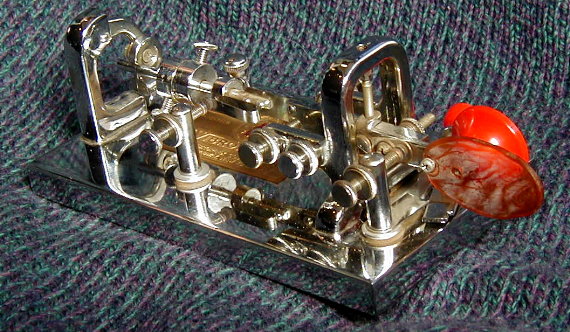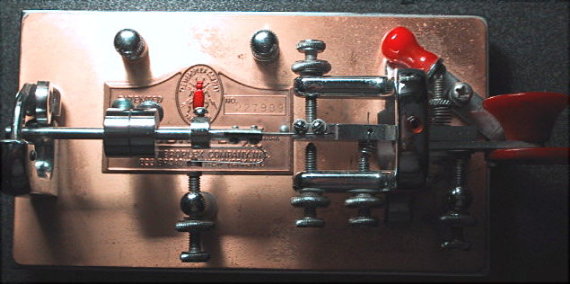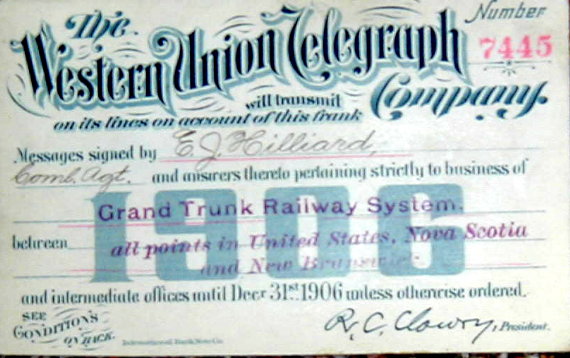Some Bug Stuff
February 18, 2001 From: K4MSG To: KD4CSO
CC: W4AU, AI2C Photos By Norm - AI2C and
Bob - K8NY
Click here for other articles by Paul posted to the LARG Internet Site
A bit of history on Deluxe model Vibroplex Bugs: During the period from before 1920 until 1940, when they were using nickel plating on the metal parts, Vibroplex offered several of their models with an optional nickel-plated base. However, this was just an optional finish, not a "Deluxe"; there were no jeweled bearings and the knob and thumbpiece were black. The first Deluxe models (of the Original, Lightning Bug, and Blue Racer) were offered in 1940 after they started using chrome plating, and featured jeweled upper and lower trunion screws and a red knob and thumbpiece in addition to the chrome-plated base. In 1943 they switched to a dark gray ("battleship gray") base for Deluxes due to the wartime shortage of chromium, and in 1946 switched back to chrome.
|
From 1940 until sometime in the mid-to-late 1940s the upper jeweled-bearing trunion screw looked just like the upper trunion screw on a Standard model, i.e., it screwed down from the top and had a circular locking nut like the contact screws. Possibly because of problems with cracking or breakage of the jewel(s) due to over tightening by over-zealous owners, Vibroplex switched to an upper jeweled-bearing trunion screw that screwed in from underneath the top of the frame and wasn't adjustable. Tension was set by the lower trunion screw and then locked by a horizontal locking screw in the bottom cross arm of the frame, so most owners left it alone. To cover the unsightly hole in the top of the frame, Vibroplex came up with a red plastic "jewel" that was threaded and screwed into the hole. Sometime in the 1970s they quit threading this plastic piece, and it now has to be glued in. A lot of them get bumped against something and snap off, thus requiring replacement. Believe it or not, I think the current price on that dinky piece of red plastic is $2.00!
This change in the upper trunion screw design on Deluxes and Presentations causes a problem if the trunion pin isn't accurately set in the lever arm, since the contacts might be misaligned vertically (NOTE: On any Standard-model bug you can adjust the vertical centering of the contacts by adjusting the upper and lower trunion screws to raise or lower the lever arm). So, at the same time that this change was made (I think about 1948) Vibroplex stopped press-fitting the pin in the lever arm and left it free-floating, then drilled, tapped and counter-bored a small horizontal hole in the lever arm. A binder-head screw in this hole is positioned such that the edge of the head presses against the trunion pin; when this screw is loosened the lever arm will slide up and down on the pin, thereby allowing for the vertical contact alignment that isn't otherwise possible with the fixed upper trunion screw on a Deluxe or Presentation. Of course, the same lever arm is used on a Standard model only with a pointed instead of rounded trunion pin, so even Standard models from 1948 until the early 1980s have a free-floating pin and locking screw.
Bob, K8NY says 'I purchased this Vibroplex
Presentation model bug new in 1963 from Grand Central Radio |
Interestingly, when Vibroplex was bought by Peter Garsoe in 1979 and moved to Portland, ME, one of the things he did was eliminate the trunion pin locking screw in the lever arm (saved a couple of machining steps, lowering production cost) and go back to press-fitting the pin. This is the way it's still done today, but the current owner, Mitch Mitchell, W4OA, has had a real problem with alignment of the pin (either an inadequate jig or sloppy assembly) and a lot of his $200+ Deluxes and Presentations have vertical contact misalignments of 1/8" to 1/4". There is only one remedy aside from "tweaking" the trunion pin up or down as necessary, an operation that isn't recommended as it poses a real risk of damaging the upper or lower pin surface that seats with the trunion screws (unless one has the proper tools - no hammers allowed!). The remedy is to remove the non-adjustable upper trunion screw on a Deluxe or Presentation and replace it with a lower trunion screw with a contact-screw locknut on it - in other words, regress back to the early 1940s design.
If you'll look closely at your bug, on the right side of the lever arm just ahead of the horizontal coil spring used for tensioning the dash lever you'll see a screw in the arm. If you loosen it, the lever arm will slide up and down on the trunion pin.
|
Regarding spark keys: Because of the nature of spark, it being a dry, raspy, hissing sound and difficult to hear (let alone copy) under weak-signal conditions, speed of transmission was significantly lower than with landline telegraph (and later CW) so there was no need for a bug. In addition, the contacts on many spark keys were designed to handle as much as 10 amps or more (they were keying the current in the primary side of the transformer) and such contacts weren't practical on bugs because of the required physical size. Vibroplex did start offering optional larger contacts in the 1930s with the advent of cathode-keyed CW transmitters (some of which might pull a couple of hundred milliamperes through the keyed stage) and your bug should have that size (the same as used today). {NOTE: You can get the crap knocked out of you on some of those old cathode-keyed transmitters by getting across the key contacts.} But for landline telegraph smaller contacts were satisfactory and when I show you my 1936 Junior you'll see that the contacts are about half the diameter of the present-day ones, and this smaller size is typical of the various older models I owned when I had my collection several years ago (including 1912 and 1919 Originals, a rare 1922 round-shaft Model X, and several other Originals and Lightning Bugs from the 1920s and 1930s).
Hope I'm not boring you with this minutae, but the details of this little mechanical contraption fascinate me no end................ 73, Paul, K4MSG
NNNN |
|


